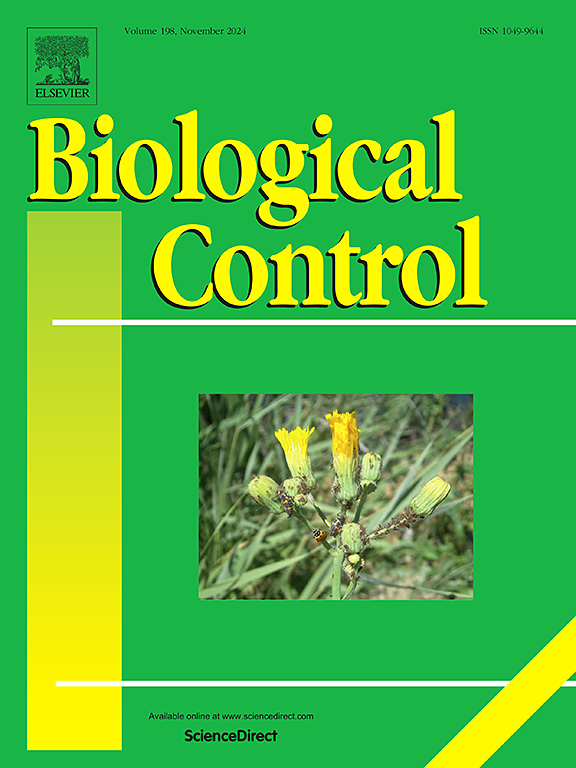棉蚜蜜露中细菌产生的挥发物介导棉蚜对猎物的定位
IF 3.4
2区 农林科学
Q2 BIOTECHNOLOGY & APPLIED MICROBIOLOGY
引用次数: 0
摘要
昆虫产生的蜜露不仅是天敌的营养物质,影响天敌的生存、发育和繁殖,而且是调节天敌觅食行为的挥发物来源。变种希波达马(鞘翅目:瓢虫科)是新疆棉蚜(半翅目:蚜虫科)的有效天敌。然而,棉蚜蜜露挥发物对杂色棉的功能意义尚不清楚。本研究报道了棉蚜粗蜜露对斑叶蚜成虫的引诱作用,并利用顶空固相微萃取-气相色谱-质谱联用技术(SPME-GC/MS)鉴定了15种挥发物。触角电图(EAG)结果表明,蜜露中9种挥发物对花椒有明显的剂量依赖性。y形管嗅觉仪和笼捕试验表明,1-庚醇、2-乙基-1-己醇、2-苯乙醇和2-甲基-1-丙醇吸引了异花斑田鼠成虫。此外,我们的研究还阐明了蜜露化合物与微生物的关系。研究结果表明,化合物2-乙基-1-己醇、2-苯基乙醇和2-甲基-1-丙醇来源于使用16S rRNA标记鉴定的五种不同的可培养细菌。我们的研究结果为加强蚜虫的生物防治提供了潜在的生态策略。本文章由计算机程序翻译,如有差异,请以英文原文为准。
Volatiles produced by bacteria in the honeydew of cotton aphids mediate prey location by Hippodamia variegata (Coleoptera: Coccinellidae)
Honeydew produced by insects is not only recognized as a nutrient-rich substance for natural enemies, influencing their survival, development, and reproduction but also a source of volatiles that regulate the foraging behavior of natural enemies. Hippodamia variegata (Coleoptera: Coccinellidae) is an effective predatory natural enemy of Aphis gossypii (Hemiptera: Aphididae) in Xinjiang, China. However, the functional significance of honeydew volatiles from A. gossypii for H. variegata remains largely unclear. Here we reported that H. variegata adults were attracted by the crude honeydew of A. gossypii, and we identified fifteen volatiles using headspace solid-phase microextraction gas chromatography/mass spectrometry (SPME-GC/MS). Electroantennogram (EAG) results showed that H. variegata exhibits a significant dose-dependent response to nine volatiles from honeydew. Y-tube olfactometer and cage predation tests showed that 1-heptanol, 2-ethyl-1-hexanol, 2-phenylethanol, and 2-methyl-1-propanol attracted H. variegata adults. Furthermore, our study also elucidated the relationship between honeydew compounds and microorganisms. The findings demonstrated that the compounds 2-ethyl-1-hexanol, 2-phenylethanol, and 2-methyl-1-propanol originate from five distinct cultivable bacteria identified using the 16S rRNA markers. Our results provide potential eco-friendly strategies for enhancing biological control of aphids.
求助全文
通过发布文献求助,成功后即可免费获取论文全文。
去求助
来源期刊

Biological Control
生物-昆虫学
CiteScore
7.40
自引率
7.10%
发文量
220
审稿时长
63 days
期刊介绍:
Biological control is an environmentally sound and effective means of reducing or mitigating pests and pest effects through the use of natural enemies. The aim of Biological Control is to promote this science and technology through publication of original research articles and reviews of research and theory. The journal devotes a section to reports on biotechnologies dealing with the elucidation and use of genes or gene products for the enhancement of biological control agents.
The journal encompasses biological control of viral, microbial, nematode, insect, mite, weed, and vertebrate pests in agriculture, aquatic, forest, natural resource, stored product, and urban environments. Biological control of arthropod pests of human and domestic animals is also included. Ecological, molecular, and biotechnological approaches to the understanding of biological control are welcome.
 求助内容:
求助内容: 应助结果提醒方式:
应助结果提醒方式:


